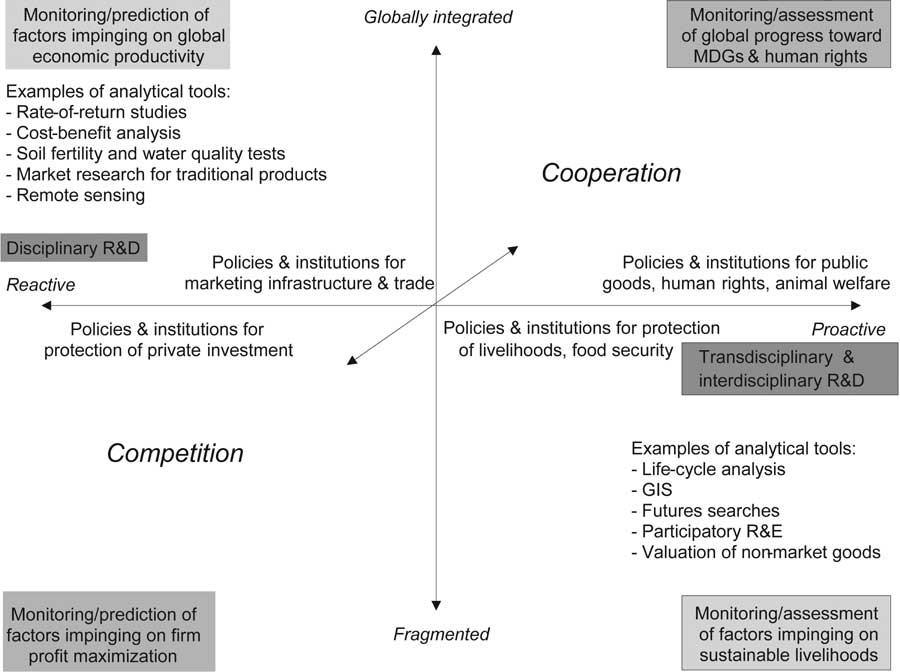Development agency and the FAO's Food and Hunger reports that showed the persistence of widespread hunger, rural unemployment and food insecurity for vulnerable populations; and studies of the land degradation, water pollution, and loss of flora or fauna species associated with narrow technological interventions. (Repetto, 1985; Loevinsohn, 1987; Repetto et al., 1989; Repetto, 1990). The growing experience of alternative ways of mobilizing science capacity (noted in 2.1.2-2.1.4) complemented these efforts and stimulated a more critical reflection within scientific communities (ODI, 1994) on the governance of agricultural science and the accountability of science as a source of innovation not only for "success" but also for "failure" in agricultural development. Institutional responses included the creation around 1995 of a system-wide program on gender analysis and participatory research within the CGIAR and the beginning of the sustained long term research that fed into the Millennium Ecosystem Assessment (MA, 2005).The ethical and political questions posed by scientific and technological choices stimulated the spread and more rigorous use of ethics committees to address a broader range of societal considerations and renewed efforts to bring together the natural, technical and social sciences. This often involved the creation of specialist cross-disciplinary organizational units charged with the task of integration around selected themes and of new knowledge networks.
Scientists trained to specialize often struggled to understand their role in these arrangements. A different paradigm, constructivism, offered a sound epistemological base for the kinds of interactive and integrative work that challenged scientists as professionals to think about themselves and their work in new ways. The epistemological position of constructivism is that reality and knowledge are actively created through social relationships and through interactions between people and their environment. These relationships and interactions are seen as affecting the ways in which scientific knowledge is produced, organized and validated (Schütz, 1964; Berger and Luckmann, 1966). An authoritative overview of empirical research studies (Biggs and Farrington, 1991) robustly demonstrated the ways in which institutional and political factors affected both the conduct of agricultural science and the translation of research results into farming practices. An important distinction became more widely understood: i.e., between knowledge as a lived experience of inquiry and hence transient and continuously re-created and knowledge products that can be stabilized (e.g., in journal articles, technologies, artifacts and in the norms of organizational behavior) and shared and under the right conditions, will diffuse. It opened the door to science not only as a source of innovation but as potentially a co-creator of knowledge in processes of enquiry shared with other actors (Borrini-Feyerabend, et al., 2004).
Collaboration among science disciplines tended to assume one of three forms: combining multiple disciplines in a single study; to a variable extent dissolving disciplinary boundaries in purposive learning from each others' disciplines and non-science actors; and transdisciplinary effort that actively sought to build new frames of meaning and understanding (Figure 2-2). The founding precepts of General Systems Theory, introduced by the biologist von Bertalanffy in 1950 informed these efforts, especially from the 1970s
onwards (Spedding, 1975; Cox and Atkins, 1979; Altieri, 1987). Strong interdisciplinary collaboration in developing systemic approaches to agroecology occurred throughout the world in the 1980s, often led by NGOs. The boundaries expanded to include on-farm fisheries, the role of wild and semi-domesticated foods and medicines (Scoones et al., 1992), forests and non-timber forest products (Ball, Carl, and Del Lungo, 2005). The agricultural sciences were newly positioned at the interface of two complex and complementary systems: natural and social systems. Translation of this understanding into practice nonetheless faced strong barriers within the scientific community and from market specialization and the dominance of economic drivers over social and ecological sustainability concerns.
2.1.3.2 A changing contract between science and society
In the immediate post World War II period in what later became grouped as OECD countries there was a tacit understanding between science and society that what was good for science was good for humanity and that science would deliver solutions to societal problems. The output response in OECD agricultures and under the Green Revolution's early successes in Asia and then Latin America consolidated this view and led over time to significantly higher national investments in AKST and science in general. The less strong impacts experienced in sub-Saharan Africa (Beintema and Stads, 2006) reflected both the weakness of the scientific infrastructures and personnel around the time of independence and the overall economic and social conditions of the time, leading to a prolonged period of donor investment to strengthen capacity (see Chapter 8). Although a few "islands of success" were created, the lack of sustained national investments meant that the capacity for science and technology development at the university, research institute or enterprise level in most of sub-Saharan Africa by the 1990s had fallen to an exceptionally low level (Eisemon, 1986; Eisemon and Davis, 1992; Gaillard and Waast, 1992). Recent renewed efforts by African leaders to build a stronger contract between their societies and science have not yet translated into adequate national investments in their own science base.

Figure 2-2. Modes of science.